The cities of Kitchener and Waterloo (“Kitchener-Waterloo”) were chosen as the study location, as both cities are affected by the Growth Plan and are currently being intensified. From March to August, 2012, a random sample of 1272 households living in homes with private yards were invited to participate in a survey on yard landscaping and maintenance practices and property preferences, after which a total of 206 surveys were analyzed.
Most respondents were living in medium-sized homes with medium-sized yards, and results indicated that homes and yards of medium size would be the most commonly preferred options if residents were to move (considering their household size, health, finances, etc.). On the whole, the target market for high-density homes (i.e. condominiums, small houses, and small yards) came mainly from the aging population. Nevertheless, when asked if they would ever live with less yard space in the future (when their household conditions could differ from what they were at the time of the survey), 58% of all respondents indicated that they may live in a home with a small yard and 41% indicated that they may live with no yard. Such a finding further indicated that residents may find high-density dwellings more appealing as they age.
Based on findings, ways of increasing the appeal of compact dwellings are discussed, such as including a small yard or balcony, providing privacy, ensuring access to public green spaces, and being located in a safe neighbourhood. Landscapes neat in appearance and designed with grass, colourful vegetation, trees, and natural gardens are also expected to increase property appeal.
Overall, if development is to remain restricted to built-up areas, developers and planners will have to create desirable high-density homes located in communities that accommodate the lifestyles of potential residents. This thesis addresses such a challenge by delineating target market groups with the potential to move to high-density homes, and by providing insight into the variables that may increase the appeal of properties as landscapes are intensified.
Within those questions, there are particular sub-questions that can be addressed. Click a tab below for more information about each question.
Q1: Who is the most likely to move to more compact dwellings?
To determine if residents currently living in homes with private yards may move to more compact dwellings and to describe the types of residents who are most, and least, likely to do so.
How would resident subgroups differ in their residence and yard size preferences if they were to move to another home?
The sample mainly consisted of medium-sized, single-detached houses, with medium to large size yards. These properties were defined as low-density for the purposes of this thesis, with higher density defined as smaller single detached residences, townhouses, condominiums and apartments. Of those surveyed, the following group preferences were discovered for low and/or higher density housing:
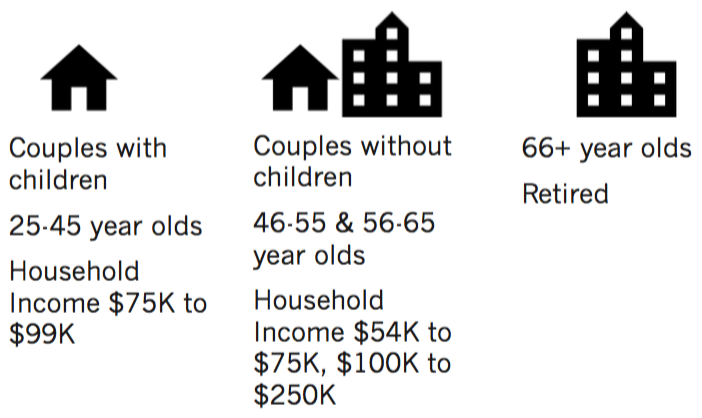
Therefore, those 66 years and older and retirees have the highest chances of moving to higher density, while those above 45 years old, couples without children, and those making $54k to $75k and over $100k have a desire for higher density living. Younger couples, particularly those with children, express a desire to have a low density home – likely from the access to private yard space. These preferences are based on the home people may desire if they were to move.
What proportions of the total sample are likely to move in 0-5 years; 6-10 years; and 11-25 years?
The majority of people plan to move within the next 10 years, while a quarter plan to remain indefinitely in their current home:
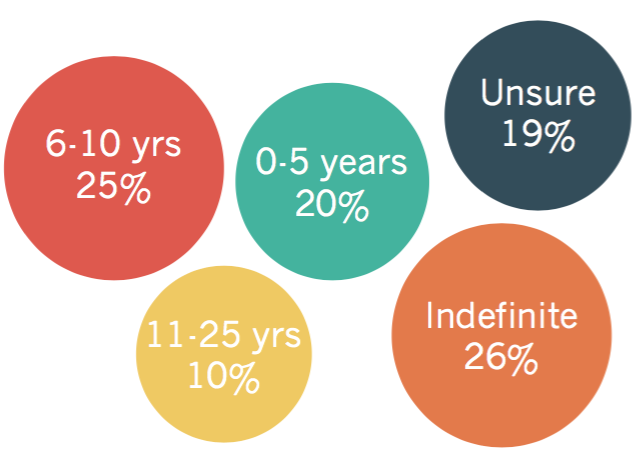
Q2: Will the proportion of residents moving from low to higher densities support the ongoing demand for low density?
To discuss whether the proportion of residents who may move from low-density to high- density dwellings is likely to support an ongoing demand for low-density dwellings.
What are the potential trends in upsizing and downsizing property sizes, according to the size of homes and yards residents currently have and the sizes they would have preference for if they were to move?
Residents have different desires for when they move, and what size of home they would move to based on their current size residence. A small home is defined as less than 1000 square feet, a medium sized home as 1001 to 2500 square feet, and a large home is greater than 2500 square feet. Of those in small homes, most would upsize to a medium home, while a smaller proportion would remain at the current size. The majority of those in medium homes want to remain in an equally sized home. Those in large homes have a desire for a medium or another large home, and have a higher chance of remaining in their current home than those in small homes. Those currently in a small home are the most likely to move in the future, with those in medium to larger homes evenly split on moving soon or remaining indefinitely in their current home. Of those who currently have small yard space or want yard space, they desire medium to large yard space in the future. This desire aligns with those in the 25 to 45 year old age bracket, and those with children under 18.
How long do residents plan to stay in their current home?
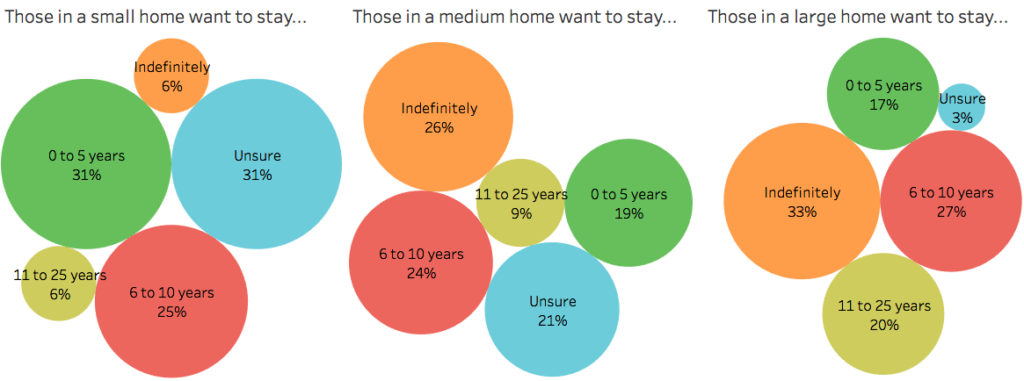
Therefore, there is a significant portion of the population that plans on moving in the future, however, that demand may more likely be for higher density units as residents wish to downsize their current home.
Q3: How do residents value and use private outdoor spaces?
To investigate if, and how, residents value private outdoor space and to determine key features of private outdoor spaces that may appeal to potential homebuyers.
How important were yard characteristics when residents chose their current home?
The majority of residents value privacy, size, attractiveness, trees, lawns and uniqueness as key features of private outdoor spaces. The chart below summarizes the factors respondents choose as either important or very important when looking for a home. 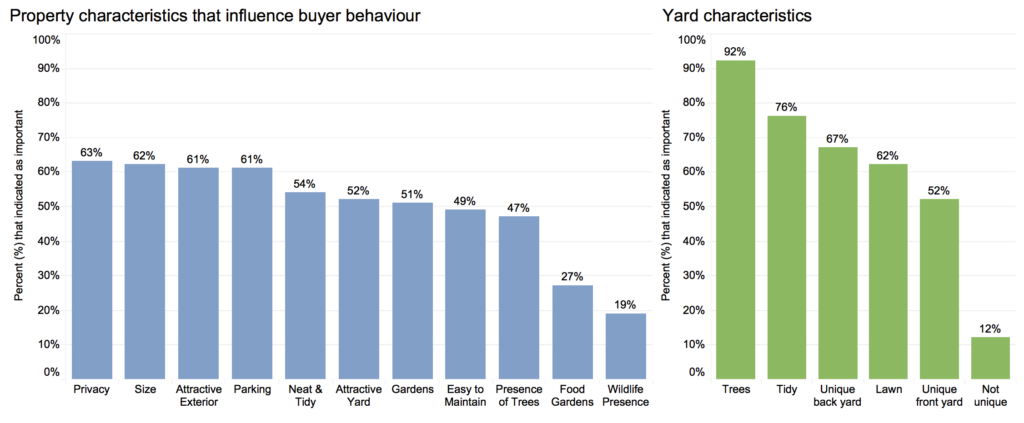
What are the important ways that residents use their yards?
Respondents indicated they use their front yards mostly for:
- Viewing the street
- Gardening
- Lawn care
- Car parking
- Washing car
Respondents indicated they use their back yards for:
- Relaxing and recreation
- Outdoor dining
- Family time
- Entertaining
- Lawn care
- Looking at the view
- Viewing wildlife
What types of yard landscapes generally appeal, and do not appeal, to residents, and why?
Respondents were asked about their preferred landscape styles. The majority liked leafy perennials, flower gardens, lawn and foundation plantings, and natural gardens. Xeriscapes were generally disliked, while stone and ground cover received mixed response. Residents cited visual appeal, environmental acceptability, and practicality as the most important factors for landscaping on a property.
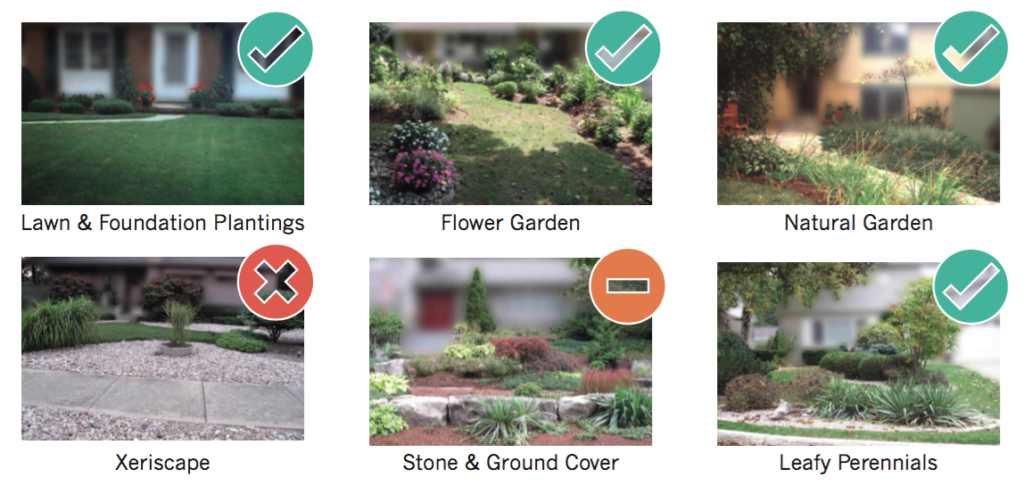
How much time and resources are respondents willing to dedicate to their yards?
Respondents are generally willing to spend more time on yard maintenance than they actually spend in doing yard maintenance. Less than half were willing to spend money on using a yard maintenance company; however, 68% were willing to spend on landscape installation by a private company, and 52% were willing to spend on landscape design done by a professional designer.
Q4: How do residents value and see appeal in public outdoor spaces?
To investigate if, and how, residents value public outdoor space and to determine key features of public outdoor spaces that may appeal to potential homebuyers.
What do residents like to have in public outdoor spaces? How important was public outdoor space when residents chose their current home?
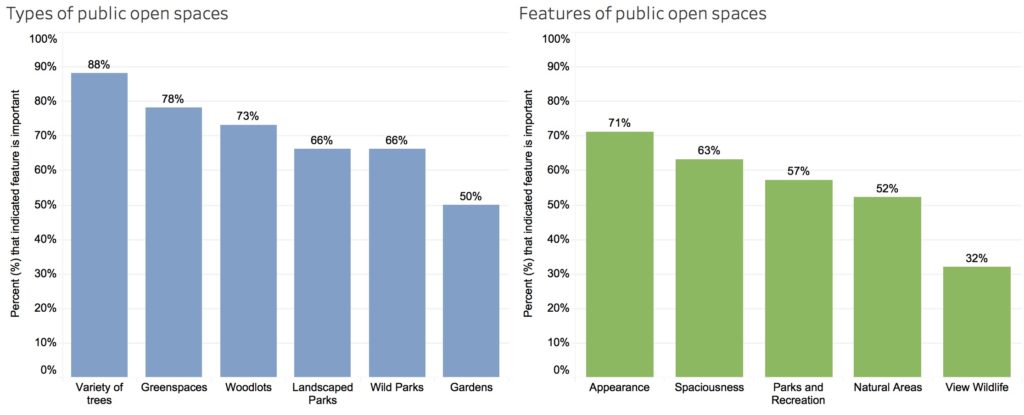
If residents were to move into a home without a yard, or a small yard, they would like the following public features:
- Nice views and landscaping
- Nearby parks and recreation
- Playspace for children
- Community garden
- Community pool
Q5: What property and neighbourhood attributes encourage homebuyers to choose higher densities?
To identify other property and neighbourhood attributes that may act as “sway factors” to encourage homebuyers to choose a property in a high-density environment.
What property and neighbourhood attributes encouraged residents to choose their current homes?
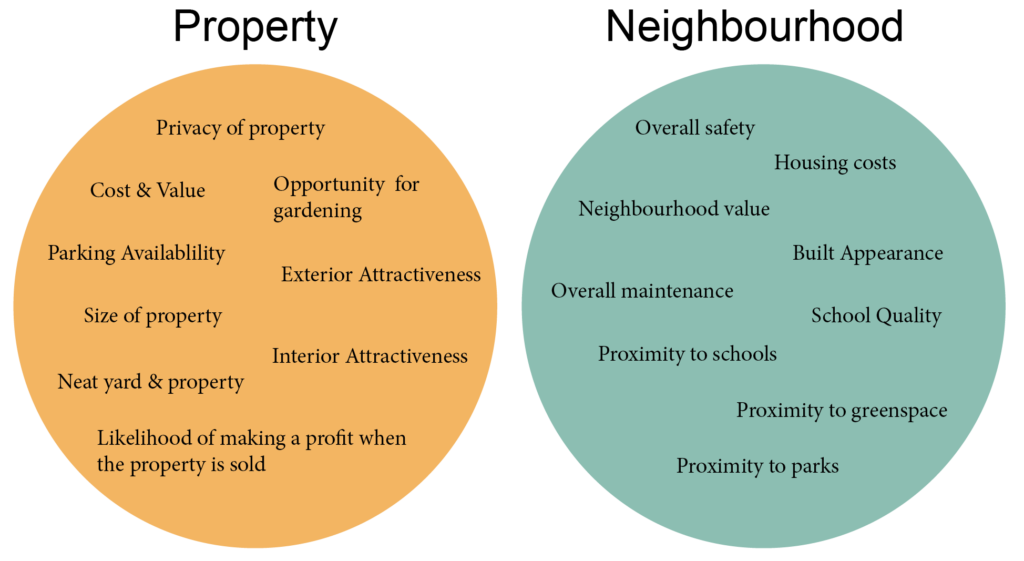
What characteristics do residents suggest may encourage them to live with a small yard or no yard in the future?
- Front porch or balcony
- Nice view from open space and windows
- Close to parks and natural areas
- Within walking distance of an urban centre
- Privacy from neighbours
Recommendations
Market higher density living to the aging population
To encourage older residents to downsize, high density dwellings should be marketed as having the comforts of single-detached homes. Incentives could be used to encourage residents to downsize to condominiums as they age, and make their condominium the home at which they “age in place”. In Kitchener-Waterloo, such incentives may come from the residence location itself, such as being near green space (parks) and the city centre. Access to LRT and other public transit may also encourage older residents to downsize, as well as additional access to healthcare in high-density buildings. Furthermore, wheelchair accessibility may be important to consider when designing homes for the aging population. Such ideas are beyond the scope of this thesis, but it is important that the goals of planners, developers, and government agencies align to encourage the aging population to downsize, thereby allowing younger populations into the existing low-density housing market.
Accommodate common yard uses in private and public outdoor spaces of high- density residences to encourage residents to move from low-density to high-density dwellings
Many of the ways that respondents commonly use their yards can be accommodated by apartment-style residences if:
- natural barriers are incorporated outside balconies to help increase privacy and reduce noise for a relaxing atmosphere
- balconies and small yards are designed to provide maximum privacy
- views are relatively unobstructed and are pleasing for residents
- balconies are adequately large or common outdoor areas can be rented for outside dining and social events
- parking and wash stations are available for those who own cars
- community and independent gardening is accommodated in common areas and private spaces
Preserve urban forests, neighbourhood trees, parks, and natural landscapes
Being close to parks and natural areas attracted residents to their homes in the past, and would encourage them to live in a home without a yard or a small yard. Residents indicated having a variety of trees in their neighbourhoods; access to woodlots, greenspaces, parks and playgrounds; and a mix of wild and maintained natural areas would be a driver for choosing higher density living.
To increase the appeal of a low- or high-density homes, ensure outdoor space is kept neat, is environmentally acceptable, is practical to maintain (for private yards), and is aesthetically pleasing.
Based on the results of the survey, leafy perennials, flower gardens, lawn and foundation plantings, natural gardens, and trees are the most preferable landscape style. The attraction of wildlife, particularly birds was identified as a positive influence for choosing higher density living. Xeriscapes, and stone and ground cover were generally not preferred as landscape styles.
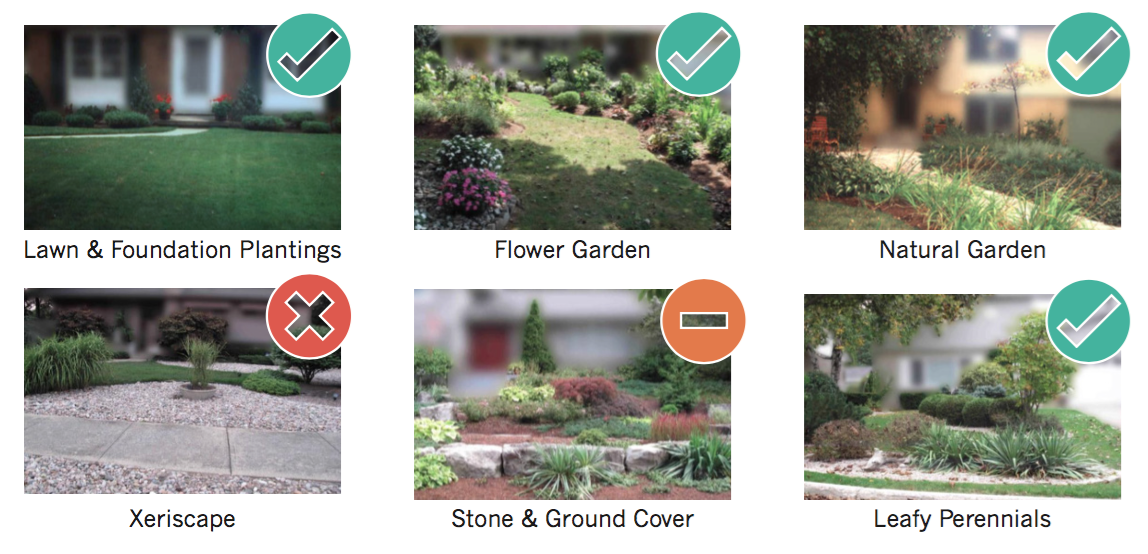
DeFields, E. 2013. Property size preferences and the value of private and public outdoor spaces amid a shift to high-density residential development: A case study of Kitchener-Waterloo, Ontario. Thesis, Master of Arts, University of Waterloo. http://hdl.handle.net/10012/7778.









